Mediasonic Probox 8-bay 3.5" USB 3.0 / eSATA DAS Review
by Ganesh T S on August 4, 2012 7:55 AM ESTPerformance Benchmarks:
In order to evaluate the performance of the enclosure, we used SSDs under the impression that they would deliver better performance compared to HDDs. We mentioned initially that the Probox doesn't support 2.5" drives. However, with careful manual handling, 2.5" SSDs could be connected to the internal ports with the unit laid sideways (to avoid the SSDs hanging off the internal SATA connectors).
The following IOMeter benchmarks were run in both eSATA and USB3 mode for configurations involving disks in 1, 2, 4 and 8 bays.:
- 128K Sequential Accesses with a queue depth of 1
- 4K Random Accesses with a queue depth of 3
- 4K Random Writes with a queue depth of 32
Despite my intent to benchmark all possible configurations for both eSATA and USB3, I found that the P8H77-M Pro's eSATA port would BSOD frequently whenever we had more than 2 drives being accessed using its port multiplier feature. Any missing bars in the above graph indicate that the test couldn't complete because of this issue. In fact, Mediasonic strongly recommends PCI-E add-on cards with Silicon Image 3132 / 3124 chipsets which have support for FIS based switching with port multiplier.
In addition to the above benchmarks, we also ran the DiskBench tests that we use in the NAS reviews. The graphs below present the results obtained in the four tests.
One of the main issues I found with SSDs was the increase in I/O response time when multiple disks were being simultaneously accessed through IOMeter. I found this mainly during access through USB 3.0. The issue may be present even in the eSATA configuration, but I am unable to confirm it due to the port multiplier issue.
In the configurations under which eSATA worked, it seems to have a steady increase in performance as more disks are accessed. Through USB 3.0, however, the performance seemed to plateau very soon. Was this something specific to SSDs or would it manifest itself even with HDDs? The next section tries to analyze this further.


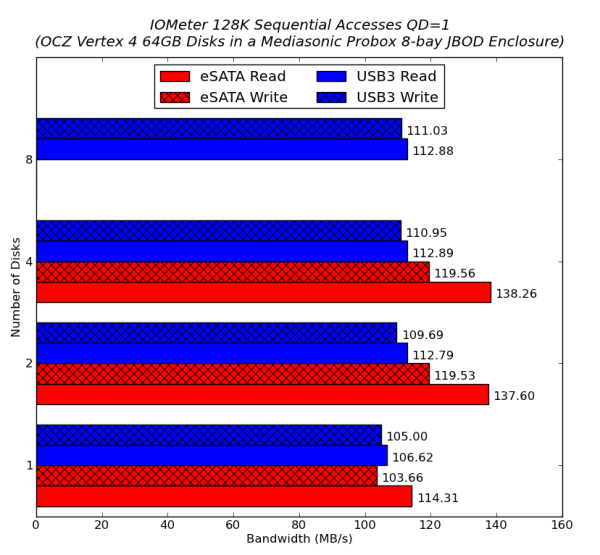
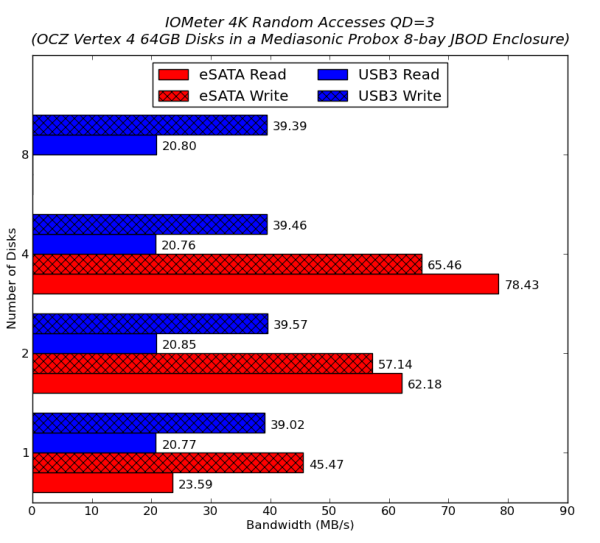
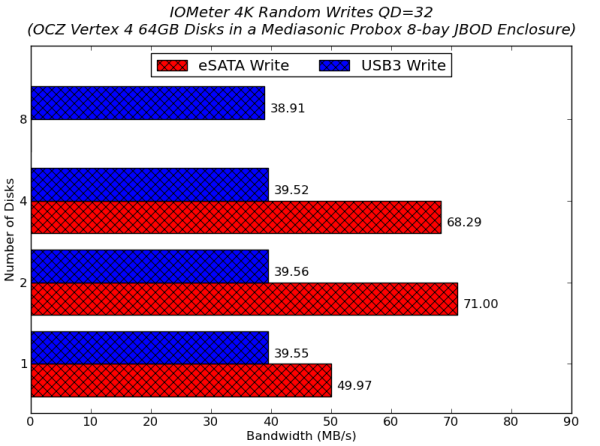
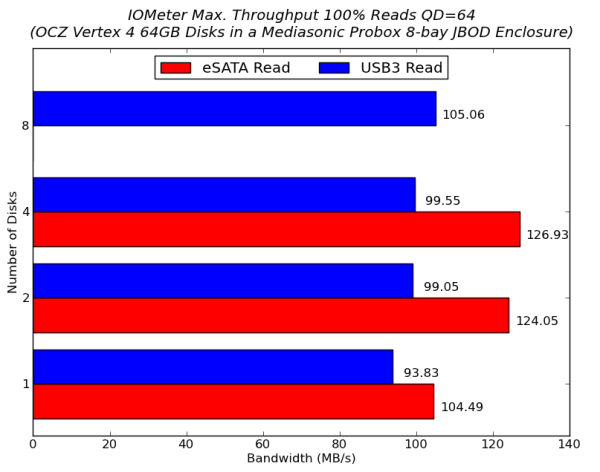

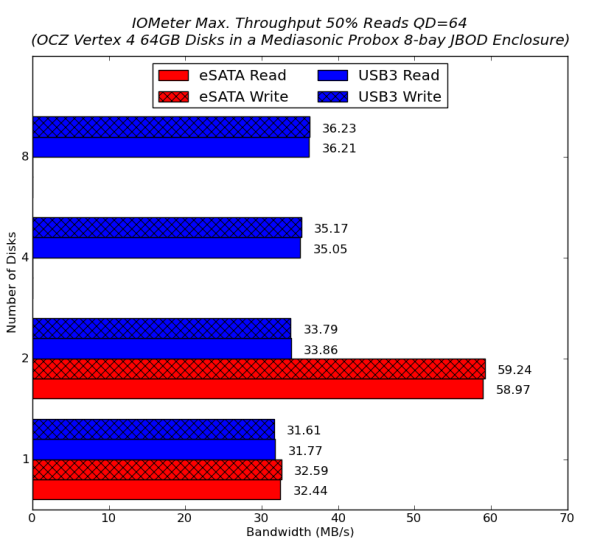
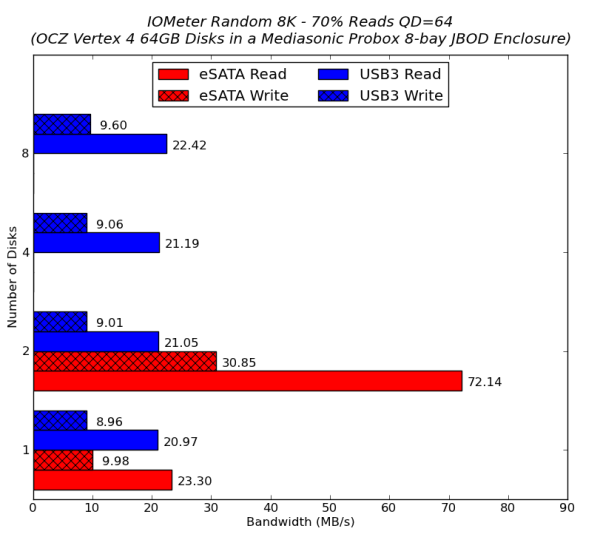








48 Comments
View All Comments
yyrkoon - Sunday, August 5, 2012 - link
Er, heh sorry TuxRoller. I mistook you for another person. My mistake.tuxRoller - Sunday, August 5, 2012 - link
Heh, no problem:)heron_kusanagi - Saturday, August 4, 2012 - link
And using a eSATA PCI-e card that supports port multiplier. I say that this HDD enclosure will really do well with a bundled eSATA PCI-e card. At least saves some hassle from the consumer side. Although USB 3.0 will solve that issue somewhat, I suppose. Still, this is a nice way to expand the HDD storage of local systems.sheh - Saturday, August 4, 2012 - link
What do people do with these things, I wonder. If it had a network interface in addition, then alright. But even then, for the price these things sell, you might just as well get a PC. More flexible, too.ganeshts - Saturday, August 4, 2012 - link
Try getting a 8-bay NAS for around $300 :) And try assembling a PC with this low power footprint when 8 drives are added. In addition, it is not straightforward to have the drives attached to a PC be visible as a set of drives for another PC (which is the point of this gadget - a direct attached storage unit)bigboxes - Saturday, August 4, 2012 - link
Straightforward for who? AnandTech readers? I have a 9 drive file server (one for the os and 8 for the files to be shared). It's hooked up to the a gigabit switch and then shared with all my home's PCs. I map all of the drives I wish to share on a particular pc. Not too complicated. It's my old A64 box. It's got 2gb of ram and more than enough horsepower to serve up files. I use a Seasonic psu that is not stressed in the least. Quiet and quite flexible. I use a couple of SATA2 pci cards to hook up all the drives. When I have trouble it's easy to troubleshoot the issue.Lonyo - Saturday, August 4, 2012 - link
I'll get back to you hopefully next week when my Celeron G530 (to be underclocked) on an mATX mobo with 8 SATA ports is ready and set up.Rather than challenging the readers to do this, shouldn't you as the reviewer be considering it, and actually exploring the possibilities?
Lonyo - Saturday, August 4, 2012 - link
Oh, and total cost for an 8 bay mATX case ($25), G530 ($50), motherboard ($80), RAM ($20), and then $50 for a low wattage 80+ PSU gives you a total of around $225 for an 8-bay box that can also have even more storage added through PCI/PCIe controller cards, as well as USB drives being connected to it.ganeshts - Saturday, August 4, 2012 - link
Guys,Everyone is talking about a NAS here, while I was talking about a DAS. Do you have a 8-bay PC which can be connected to another PC and have all the 8 bays visible over a eSATA or USB port?
The whole intent is to have storage which can be taken from PC to PC without disassembling, and operating at the max. bandwidth provided by USB 3 or eSATA. With all your solutions, you can either access the drives at full bandwidth only on that host PC or on another PC through a GbE link limited by many other factors.
yyrkoon - Saturday, August 4, 2012 - link
People use these things to have potentially flexible, fast and economical storage.Sure it can be more complex to setup. But power consumption wise. It will almost certainly win over a NAS. Which in turn relates to the never ending cost of the device running over time. It will almost always be faster, and can be just as bit as flexible as a NAS. Although, a network not withstanding. Can only connect to one system at a time.
It all really boils down to taste, and thought process put into your final objective.